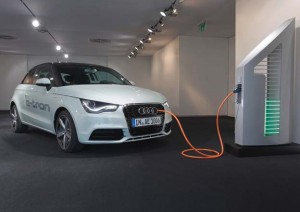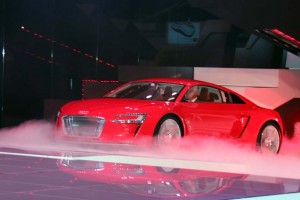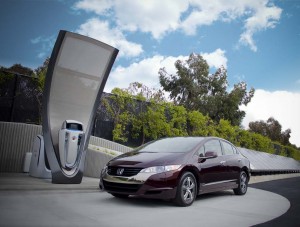
A prototype Audi eTron draws power from a solar-based charger, a system that will be used extensively at the assembly plant in Ingollstadt.
They’re called “zero-emission vehicles,” but skeptics often question just how environmentally-friendly battery cars are, citing the fact that, at least in the U.S., a large share of our electric power comes from coal.
Audi aims to modify skeptics, as it begins ramping up for the eventual production of its eTron battery-electric vehicles, by covering the roof of its Ingollstadt assembly plant with solar panels. Eventually, that power will help give a truly emission-free first charge as eTrons begin rolling off the line.
By the end of the year, Audi says it should have more than 80,000 square feet of photovoltaic cells in place, with the eventual goal of expanding to 205,000 square feet. Considering the steady improvement in the efficiency of photo cell technology, the latest addition alone is anticipated to provide about 460 megawatt-hours of electricity, enough current to power 180 homes. All told, Audi expects to produce about 1,500 MWh from its various solar installations.
“This concept shows that Audi is tackling the topic of electromobility systematically,” said Plant Manager Peter Kössler. The photovoltaic installation uses innovative thin-layer modules that satisfy the most stringent environmental protection, efficiency and flexibility standards. “We aim to set the standards in every area,” added Kössler.

The original eTron Coupe was a pure battery-electric supercar. A second version has been switched to a plug-in hybrid drivetrain.
While one of the primary purposes of the project will be to power up newborn eTrons, a fair amount of that energy will also be used to run the plant, with excess current shunted into the local Ingollstadt electrical grid.
Audi has also been ramping up the use of solar power at its second assembly plant, in Neckarsulm, where photovoltaic cells already cover the roofs of several garages and produce an annual 1,000 MWh.
Of course, that doesn’t solve the problem of where to get green power for the people, so to speak, though Germany has been one of the more aggressive participants in the push for alternative energy. The region around Hamburg, for example, is dotted with wind power farms.
As for the eTron, Audi first introduced the name at the 2009 Frankfurt Motor Show bolted to the back of a high-performance battery-powered coupe that closely resembled the maker’s conventionally-powered R8 supercar. At the Paris Motor Show, earlier this year, the eTron name was back, but this time on a plug-in hybrid cabriolet powered by two electric motors drawing current from a 9.1 kilowatt-hour pack to drive the Spyder for up to 31 mph – though at speeds only up to 37 mph in electric-only mode. For those who might want to push it like an Audi R8, a 300-horsepower twin-turbo TDI V6 diesel would kick in.

Honda is using this prototype solar-powered hydrogen pump for its FCX Clarity fleet, in Southern California.
Other makers have been looking at ways to go greener with their own alternative vehicle fleets. Honda, for example, has set up a prototype solar-powered hydrogen pump for its fleet of FCX fuel-cell vehicles, in Southern California. The sun’s energy is tapped to produce the lightweight gas by electrolyzing water into its basic elements.
The Nissan Leaf battery-electric vehicle, meanwhile, can be equipped with a solar panel on its rear wing, which helps run the onboard climate control system when the vehicle is parked, helping to keep the cabin at a more comfortable temperature for a returning motorist.
